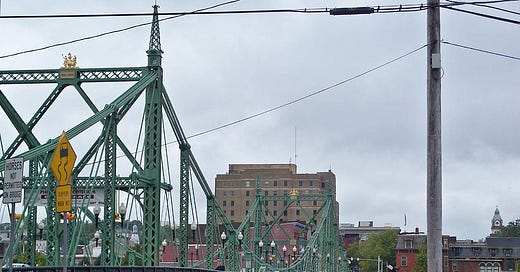Earlier this week, I had a piece in RealClearPolicy on Pennsylvania’s housing crisis, particularly in the Lehigh Valley, which encompasses Easton, Allentown, and Bethlehem, and sits between the New York City and Philadelphia metro areas.
America really has two housing crises, as I briefly noted. The one that gets talked about the most is the unaffordable “superstar cities,” whose slow housing growth triggers both high prices and urban sprawl. The Bay Area, New York City, and the Washington, D.C. metro area are the most clear-cut and high-profile examples of this.
Then, there’s the Rust Belt’s housing crisis, in which prices and demand are too low, causing neighborhoods to slowly become vacant and blighted. Read Akron, Ohio-based urbanist Jason Segedy for a great, detailed explanation of how expensive it is to rehab an old house. When prices are too low, it just doesn’t pencil out. (Ironically, even many of these Rust Belt metros are growing; there’s new construction on the edges while the old urban cores often stagnate and bleed population.)
Pennsylvania has distressed communities, particularly in the Coal Region, and it also has some very affluent suburban communities, particularly in Philadelphia’s “collar counties.” (Quick aside: One reason I love watching presidential election coverage is that it’s one of the only times you get to see American geography in all its granularity and idiosyncrasy.)
But the Lehigh Valley, the focus of the original piece, is seeing a different dynamic, and it’s really interesting. The region has long had an exurban nature to it: NYC and some Philly commuters were moving there at least as early as the 1990s. In the New Jersey portion of the Lehigh Valley (yes, that exists!), there’s a now-vacant A&P supermarket built in 1996, surrounded by farm fields interspersed with sparse subdivisions. Take a look at these photos, and definitely read the description below.
Empty A&P plaza in middle, at marker. Outside Washington, NJ. Copyright 2021 Google Maps.
But the bulk of this region is in Pennsylvania, around Easton, Allentown, and Bethlehem. And even out here, the exurban aspect of the housing market is a major and increasing reality. Remote or hybrid workers from New Jersey and New York, fleeing taxes or looking for relatively cheap housing, are essentially bidding up the prices of Lehigh Valley housing to a point where those with roots in the region can no longer afford it.
The Lehigh Valley is familiar territory for me, as is Bucks County. And at first, this new housing dynamic was a little surprising to me. I remember many bridge crossings from New Jersey to Pennsylvania (that’s one cool little thing about central New Jersey, where I grew up); my parents often took day trips out to the Lehigh Valley and nearby areas. A tour of the Martin Guitar Factory in Nazareth, a stroll in Doylestown, lunch in New Hope, shopping in Peddler’s Village, the Crayola Experience in Easton.
Easton, PA as seen from Phillipsburg, NJ
Maybe the car rides wore me out, but the word that comes to mind is sleepy. In the late 1990s and early 2000s, these were quiet, fairly pleasant locales with a bit of a timeworn feel, a certain stillness and lack of trendiness. They didn’t feel unsafe or blighted (though there were probably distressed areas we didn’t visit), just a little old fashioned and maybe a little boring.
Other cities elsewhere in the state, enjoying relatively recent economic fortunes, produced a similar impression. For example, downtown Binghamton, Scranton, and Wilkes-Barre all still have department stores, branches of the surprisingly resilient Boscov’s regional chain. A great number of Pennsylvania’s towns and cities have improbably retained a classic, tight-knit, “fine-grained” urban form over the decades. These are not places you would have expected, 20 or 30 years ago, to be hot markets. But now, they’re growing again after a long post-industrial interlude, and the nation is rediscovering a preference for traditional urbanism. Old is new.
It’s clear, however, that housing will have to keep up, and that the current economic growth in the Lehigh Valley is not just a flash in the pan. And if new housing takes the form of sprawl, eating up countryside, intensifying traffic, and failing to connect with the region’s historic settlements, that would really be a shame. Pennsylvania has absolutely incredible urban places, and hopefully we can use those places as a template and pick up where we left off. It’s not clear that’s happening anywhere near enough. From the piece:
As the Morning Call reported, “Since 2014, projects encompassing 887 apartment units have gone through Bethlehem’s approval process, but none is considered affordable housing…Some of those units have yet to be constructed.” This amounts to about 125 new units per year in a growing city – not nearly enough. At this point, many prospective homeowners are giving up.
And this here is perhaps the broad takeaway:
Pennsylvania’s affordability crisis isn’t the result of young families trying to live in neighborhoods they can’t afford. In the supermarket, you can buy the budget product if you can’t afford the premium product. In our broken housing market, there’s often no other option. That’s increasingly the case in regions like the Lehigh Valley.
In other words, the housing issue is very much—almost entirely—a policy problem, not a problem of individuals lacking a work ethic or acting entitled. Houses near jobs, vibrant places, and communities that can accommodate people from many demographics and stages in life are public goods. They’re the kind of places this country was built on.
Pennsylvania, more than most states, already has the blueprint (and has destroyed relatively little of it over the decades through urban renewal). Its sleepy, timeworn urbanism is ready for a generation of Americans that once again appreciates it. It’s time to treat these places, which for many years were fossils, curiosities, or museums, as living, breathing, growing, but remaining essentially what they are.
Photo credit Jim R. Rogers, CC BY-SA 2.0
Related Reading:





